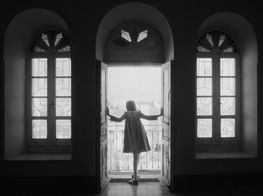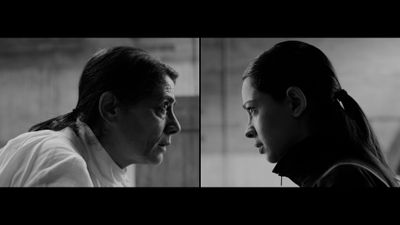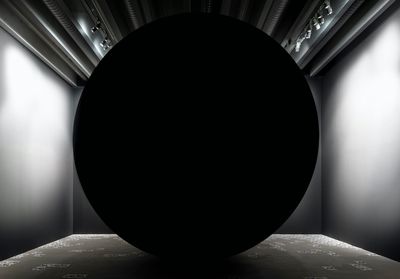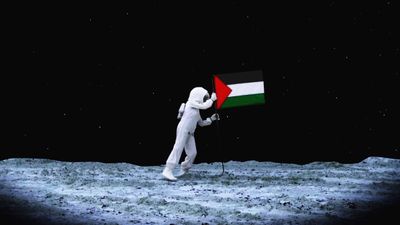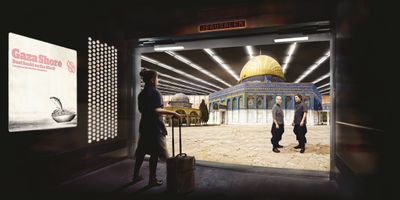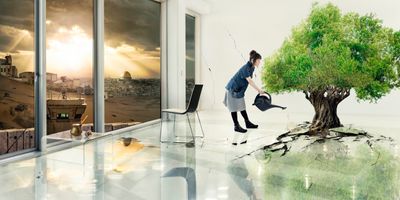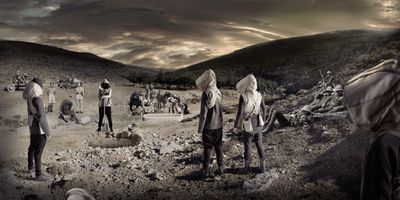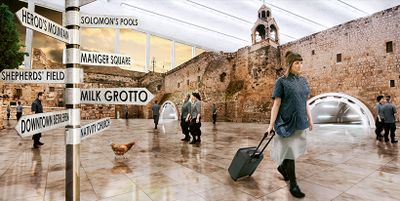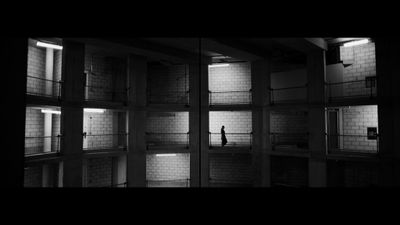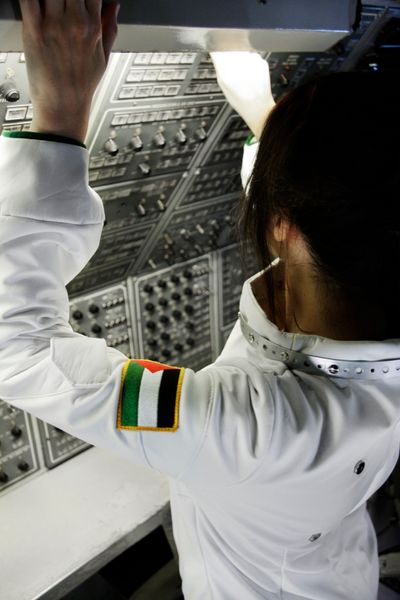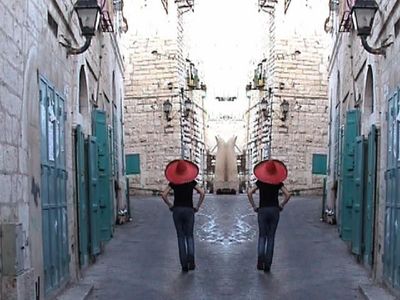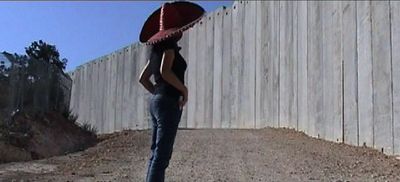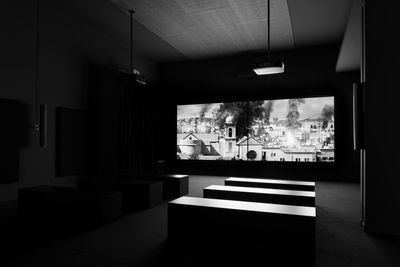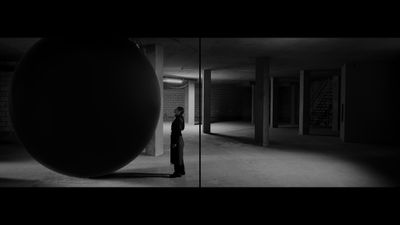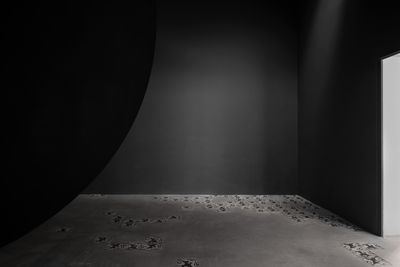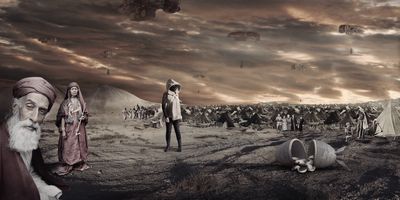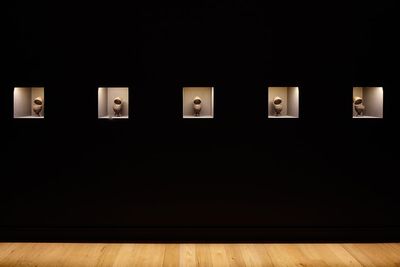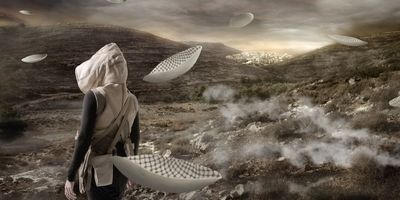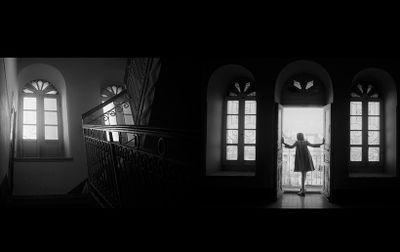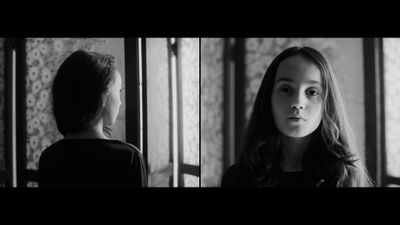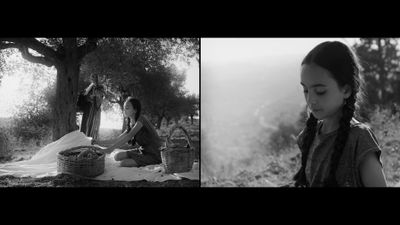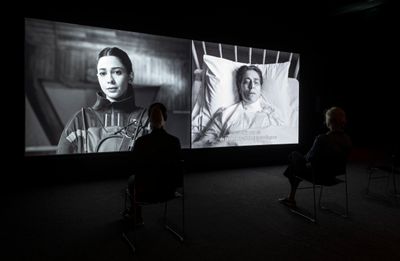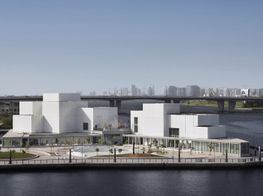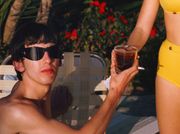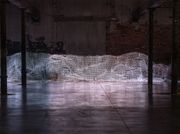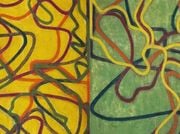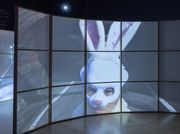Larissa Sansour: Filming a Vanishing Present
Larissa Sansour. Photo: Lenka Rayn H.
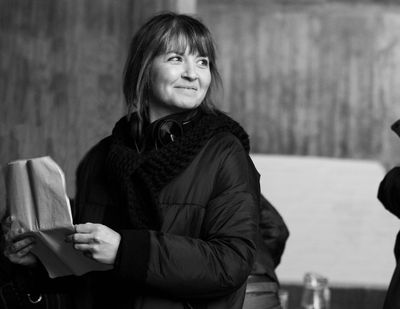
Larissa Sansour. Photo: Lenka Rayn H.
Set in Bethlehem, Larissa Sansour's recent two-channel sci-fi film In Vitro (2019) addresses the aftermath of an ecological apocalypse.
Sansour situates her work between past and future, tracing a vanishing present. At the brink of climate catastrophe, the 'now' becomes the point of transition between what was and what will be. In the wake of Beirut's 4 August 2020 blast, In Vitro recalls Sansour's research into the annihilation of memory.
The premise of In Vitro is that all forms of memory—archival, communal, and inherited—hold us back. Old memories can be replaced with new ones in order to create a brave new world. Fiction is accorded a major role in constituting our histories and political realities. The black-and-white film takes place in a cold underground bunker of science and nostalgia, where clones of children lost to the disaster are engineered to embody memories that don't belong to them.
From her deathbed in an abandoned nuclear reactor, a scientist (Dunia) steers the next generation, including her successor (Alia), a clone of her dead daughter. A thought-provoking script runs through the Brutalist bunker insulated from the outside environment, where an orchard is being cultivated with heirloom seeds salvaged pre-apocalypse. There are sharp edges and split screens through which monochrome bodies and objects move and burn. A light switch demarcates day from night, and remembrance from oblivion.
Bethlehem, envisioned as an ancient city of religious and historical significance, and the locus of this environmental catastrophe, becomes a city of the future. Speaking to a calamity that is global in reach yet Palestinian in origin is a political statement on the inevitability of humanity's demise.
In Vitro was recently shown at Dubai's Jameel Arts Centre (20 June 2020–3 January 2021) and is currently at Sweden's Bildmuseet for the artist's solo presentation, Heirloom (27 August 2020–11 April 2021), which includes the room-sized Monument for Lost Time (2019), an architectural iteration of the computer-generated sculpture in the film, which was first presented at the Danish Pavilion of the 58th Venice Biennale in 2019.
A number of Sansour's works incorporate an expanded practice of installations based on filmic threads and performative, sculptural interventions; but as one of six artists awarded the 2020 Jarman Award for moving image, Sansour is clearly approaching the language of cinema.
Her sci-fi trilogy of short films, A Space Exodus (2009), Nation Estate (2012), and In the Future, They Ate from the Finest Porcelain (2019) pre-empted this positioning. From politically motivated astronauts to archaeological militancy, Sansour's symbols of an imagined Palestinian statehood have become more abstract; her use of the futuristic genre is a literary conceit rather than a framing device. Narrating the Palestinian predicament is a point of departure for a broader discourse that disrupts dominant histories of nation-building, colonial claims to territory, and myth-making as realpolitik.
Accessing wider publics, her work is less confrontational than before, as with the revoke of her nomination for the 2011 Lacoste-sponsored Elysée Prize because of her pro-Palestinian stance. Although the latter made her concept sketches so wildly popular that their sales funded the film Nation Estate, which was originally submitted for the Musée de l'Elysée competition, today Sansour is more concerned with readings that are far-reaching, with viewers approaching the work out of fascination rather than because it suits a particular agenda.
Her latest three-channel video, Genetics Opera, commissioned by FACT Liverpool for the upcoming exhibition Stories of Us (7 July–10 October 2021), dramatises her research into epigenetics through Arabic opera. It will include an Arabic soprano, the futuristic interpretation of traditional Palestinian dress, archival footage, and computer-animated DNA strings, cells, and embryos.
Also rooted in Palestine, this piece broadens our understanding of the Palestinian condition of exile by connecting it to other displaced and dispossessed people in terms of the genetic transmission of trauma from parents to children. As a U.K.-based Palestinian-Russian artist who left Palestine in her teens and represented Denmark at the 58th Venice Biennale in 2019, Sansour's cultural affiliations are many, but as she grows with her art, it moves further with her.
NKLarissa, it's hard to believe that the last time I interviewed you was almost a decade ago for your film Nation Estate, in which Palestine's statehood and the politics of exclusion were imagined through high-rise simulations and monumentality.
Revisiting the film now, it recalls the palpable anxiety of a post-9-11 world, which meant a very different thing for travel then. How bizarre is the mood in the U.K. now with Brexit?
LSThere are so many strange ideas about a glorious past. It's amazing how Britain isn't confronting its own history. If you're trying to teach the new generation about the legacy of your colonial power, you'd think nobody would vote for this.
NKOne of the greatest struggles today is the level of intolerance that exists within nations. I come from a very divided country. This year has been devastating on so many levels.
LSYes, especially in Lebanon. The last time I was there was in 2018 for my Sci-Fi Trilogy show at Dar El-Nimer. When did you leave Beirut? I wasn't aware you lived in Dubai.
NKI left four years ago—I don't know how you can really inhabit Dubai to be honest. I do miss the feeling of being connected to a place but it's catastrophic in Beirut right now.
Most people have accepted that they won't be able to rebuild what was. This leads me to your films, as they often deal with large-scale destruction and the notion of cultural erasure.
LSTrue, and often through over-the-top symbolism, like with Nation Estate, where I was trying to tackle Palestinian identity in relation to the experience of loss.
In Vitro questions the cyclicality of history and the fact that no matter where we are heading, revision is always needed
We always remember the Nakba, the 1948 Palestinian exodus, and project a future Palestinian state. While we hold on to this very reductive idea of Palestinian-ness through symbols—the national flag, the right-of-return key, the olive tree, signifiers of what we believe ourselves to be—the present is disappearing.
Nation Estate showcased these as artefacts in a sterile building, akin to a museum. For me, this is very problematic. Therein lies the problem of an identity that is located in trauma.
NKThe present also becomes intolerable. I'm teaching a visual literacy course that reads the city of Beirut in terms of dualities such as terror and tourism, lawlessness and leisure, questioning what speculative visions of the city might arise.
With your latest work, In Vitro, you've conceived a generation of clones who will rebuild the destroyed city of Bethlehem. What was behind your envisioning of this ecological calamity as a black, obliterating deluge?
LSThe black liquid is a recurring trope in science fiction, often referencing greed and a collapsing world economy based on fossil fuel, but it also conjures up past near-apocalyptic disasters, such as the 1991 Gulf War oil spill.
The work is based on binaries: the rift between two generations, the above ground and below ground, the real and fictional, the split screens. So the choice of working with a black-and-white image came organically.
It was important to begin with these oil spills gushing through the city and into the Church of the Nativity, setting it on fire. For me, all of Bethlehem's iconographies and structures had to be dismantled before the dialogue could start.
The black liquid signifies a manmade natural disaster, but on a metaphorical level, it also represents the rupture of homogeneous time in Palestinian history. In the most basic terms, it refers to the Nakba.
NKIt's like starting from ground zero, except ancestral history cannot be obfuscated. In these conditions of shared trauma, to what degree is memory collective, and to what degree is it personal?
LSI wonder how many of our memories are really events that we remember, or those which have been transmitted to us. Questions of the blurriness between personal and collective memories are central to the film, as well as state and global memory, to a wider extent. Including archival footage from the Imperial War Museum and UNRWA [United Nations Relief and Works Agency for Palestine Refugees in the Near East] was significant because I wanted to underpin this blurry line.
I am very interested in the formation of memory. Seeing Palestine change so rapidly, one can't help but start doubting one's own recollections. In a greater sense, the film also speaks of planetary memory, framed in an environmental disaster scenario.
NKYou've been working with short films for almost 20 years now, but it seems as if you were always dreaming up a feature film. What were your influences?
LSI don't think my influences were coming out of the art world or Arabic literature. When I was invited to exhibit with Afrofuturist artists at the Studio Museum in Harlem in 2013, I was amazed by how similar our approaches were. Coming from marginalised cultures, we were using the tools available to those ruling over us, claiming that space and reversing the analyser and the analysed.
I think it does us a lot of disservice to have Palestinians as the subjects of documentaries, because people either feel sorry for them or fear them. This changes the power dynamics.
NKYour past work is known for your sense of irony in more experimental forms of documentary. Recently, your works are becoming more philosophical and narrative in form, less symbolic. Has your language changed?
LSYes, I completely see that. I've lived outside of Palestine for most of my life, I left when I was 15. I didn't want to be dictated in my role as a woman artist from the Middle East.
Back then, I found that a lot of curators expected something very particular from me, so I wanted to make polished work, in a form you wouldn't normally associate with artists from the region.
In A Space Exodus, I try to instrumentalise the sci-fi genre, separate from, say, Hollywood films or countries associated with progress and advancement. I wanted to topple those frameworks.
NKYou've also stopped acting in your videos and using the documentary form. Is this a form of distancing yourself from your work?
LSAt first, it was for budgetary reasons, like with Bethlehem Bandolero in 2005, when I played a Mexican gunslinger roaming the streets and confronting the Israeli wall. I just used my own camera and edited myself.
After the wall was built around Bethlehem and Israeli settlements started to zero in on the city, people from surrounding villages had to choose which side they wanted to be on because it became a border that couldn't be easily crossed.
When I was growing up under military occupation, Bethlehem was historically and geographically connected to Jerusalem, where you could find all the major hospitals, restaurants, and shops. With the wall, Bethlehem got cut off and had to depend on itself. Now, it's a busy, dense city, very different from the sleepy Mediterranean town I used to know.
While we hold on to this very reductive idea of Palestinian-ness through symbols—the national flag, the right-of-return key, the olive tree, signifiers of what we believe ourselves to be—the present is disappearing.
Many people and artists started documenting the way it was, or is, because of the fear of what would be erased. Film was significant then as a document of the real, as an archive.
It was important for me to appear in my films and include my family. Now I'm much more interested in how we can talk about broader themes, where Bethlehem is a microcosm for larger problems the world is facing. I also grew with my work somehow.
NKWhat's it like working with your life partner Søren Lind on your scripts?
LSWe've been working together a lot over the years. We develop the concept and then we each flesh it out in different ways.
Søren is the writer, he's much more rational than me—I take everything into this outlandish realm, adding phantasmagoric elements while he keeps the philosophical arguments intact. We're always surprised as to where each project leads.
NKI'm interested in the excavational impulse behind your work and the juxtaposition between fictive archaeologies, which propagate the myth of the nation, and architectures of the future. How are you constructing this world you are positing, which isn't entirely a hopeful one?
LSI don't have answers for this, but I think it's a discussion that needs to be had. In Vitro is very much about the need for this conversation to happen and also an attempt to show the blurry line between utopia and dystopia.
In a way, Dunia and Alia are two sides of the pond. Dunia is the conservative who thinks things have to change slowly, and that we have to learn from our memories, while Alia thinks that we can start from a tabula rasa, completely anew. That's somehow what communism wanted to do. History was seen as evil and society could be utopian as long as structures were in place.
NKDunia creates a reverse chronology by stating that 'the present imposes its language, projecting the meaning of this very moment onto the past. The past never was, it only is.' How do you see her depiction of the archive?
LSArchives, documentaries, and memories are always functions of present-day narrative structures, and as such devoid of any absolute truth value, stripped of any innateness.
Pasts, she tries to convince Alia, only exist in their current versions, and Alia's failure to connect with the traumas of the past hence relies on a fallacy, an integral entity residing outside of our understanding of it.
NKI think Dunia fears that these structures will die with her whereas Alia, although a clone of her daughter, has a mind of her own and isn't entirely programmable.
LSThe clone also questions the idea of what is real and what is fiction. At some point, Alia says to Dunia, 'This is your exile not mine.' Her whole world is underground.
For her, that is what's real, even though Dunia raised these clones to think that the place they live in is nothing more than a corridor for a better world that they're going to repopulate, later when the earth becomes habitable.
I think In Vitro questions the cyclicality of history and the fact that no matter where we are heading, revision is always needed. That's actually the start of the film that I'm working on with Søren right now.
It starts where In Vitro left off, in the form of a Palestinian Truman Show where a bunch of clones are let out in Bethlehem. But they're still supervised by Dunia and her friend from the bunker, Maha, who both watch their every move to see if their experiment will work out.
NKYour films expand into performative actions and sculptural works such as Monument for Lost Time, which is featured in In Vitro but also occupies an entire room as part of Heirloom. How did you come up with this spherical form, symptomatic of a certain void or absence?
LSThe sculpture came after we worked on it in the film, where it was all CGI—the actors were basically interacting with nothing. It functioned as an ephemeral repository of Alia's angst, her negotiation of past and present.
When taken out of its filmic space, it becomes something completely different. The sculpture is currently showing at Bildmuseet in Sweden with the film.
We aimed for the blackest of blacks, which turned out to be owned by Anish Kapoor, so we were only able to use the second darkest after signing a paper saying that we weren't Anish Kapoor.
The whole point with the non-reflective form obstructing light was to collapse time and space so you don't have a sense of dimensionality.
I think utopia and dystopia are constantly engaged in a long dialectical dance that generates history as we know it.
NKIs it a monument that materialises the aftermath of the cataclysm?
LSIf Dunia is someone who holds onto the past and Alia is the future, then the sphere is the burden of the present.
NKYou've created different kinds of sculptural interventions for In the Future, They Ate from the Finest Porcelain, where a series of keffiyeh-adorned porcelain pieces was buried by a resistance group as archaeological proof of a counterfeit civilisation, and in order to lay future claims to land.
LSThis was based on how good Israel is at creating facts on the ground, and how these become unshakable truths. I wanted to use the same methods, wondering how long it would take for objects in the ground to become truths if they belonged to a fictional film.
It could only make sense if I did an intervention. For Archaeology in Absentia, we chose 15 different locations to bury the porcelain plates, with the help of various institutions. Each location's coordinates are engraved within bronze sculptures that resemble both Fabergé eggs and Cold War Russian nuclear bombs. It's a straightforward representation of archaeology being used as a weapon, rather than epistemologically.
In Israel, archaeology is headline news; it supports arguments. The film tracks a leader that calls herself a narrative terrorist.
'Narrative terrorist' makes me think that the only form of subversion is through language rather than violence.
NKYou speak a lot about how science fiction creates new languages and the possibility of looking at the world differently. What does the future look like in your work?
LSIt doesn't look like your typical future; it's always retro. What fascinates me about science fiction and makes it appropriate for the Palestinian condition is that once you take out all the signifiers of what is considered Palestinian, you lose the identification.
For In Vitro, I was commenting on the time I grew up in 1970s Bethlehem and melding different temporalities. I wanted to recreate a tactility you see in the outskirts of Bethlehem when the girl is playing and touching the stones in the environment around her, but I also wanted to have a sterile place and Brutalist architecture.
We filmed the hospital scenes in Oxfordshire, in an abandoned boarding school. It was the perfect sci-fi set, because it had an element of horror.
NKSpeaking of horror, your earlier film features the downpour of porcelain, a bizarre apocalypse that is likened to a Biblical plague.
NKDunia mentions that the warning signs of apocalypse were apparent elsewhere, but Bethlehem was always a place that was very 'charged'. It's as if Palestine becomes a node in a much larger kind of network of natural disasters.
LSNationalist sentiments are rising everywhere in the world, where we define our identities in opposition to the Other. All sense will be lost when the whole world as we know it disappears after environmental disaster.
What do we do with everything that we have known? We're facing imminent collapse and that is an important backdrop to consider when making sense of the dialogues that are available to us.
NKSo nation-building becomes obsolete in times of extinction and Alia is saying that there is no need for the myth of the nation. Where do you position yourself between Dunia and Alia?
LSI'm not taking sides, but I do understand both points of view, which I feel need to be presented.
NKDo you see yourself creating art at all outside of conflict or impending doom?
LSIt is hard for me to operate in a vacuum, as I always respond to the context in which I find myself. I think the sense of looming disaster is a universally shared one.
In terms of our humanity, we will soon have to make tough decisions and revise the systems we have in place. I think utopia and dystopia are constantly engaged in a long dialectical dance that generates history as we know it.
I do not think that the apocalypse is a necessary step for an acceptable future, but throughout history, hard times have accelerated our need for innovations, revolutions, and revisions, and I think these cycles are bound to repeat again.
NKAs your narrator says, 'The apocalypse is never that single cataclysmic event. It sneaks up on you.'
Given your employment of scientific methods to legitimise fictional histories, would you say that both science and fiction are essential for our survival as a species?
LSYes, the scientific progress and the stories we tell about ourselves and our past both play a vital role, science for our species and fiction for our self-understanding and identification—as individuals, cultures, nations, human beings.
Within the framework of the film, the fictional aspect—in the narrative and the impact of myth on historical understanding and political identity—outweighs the science.—[O]

